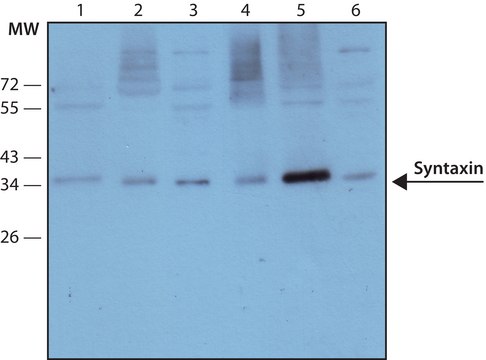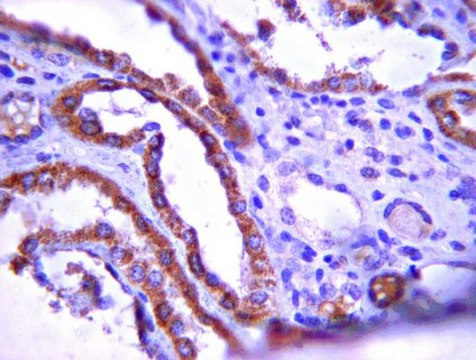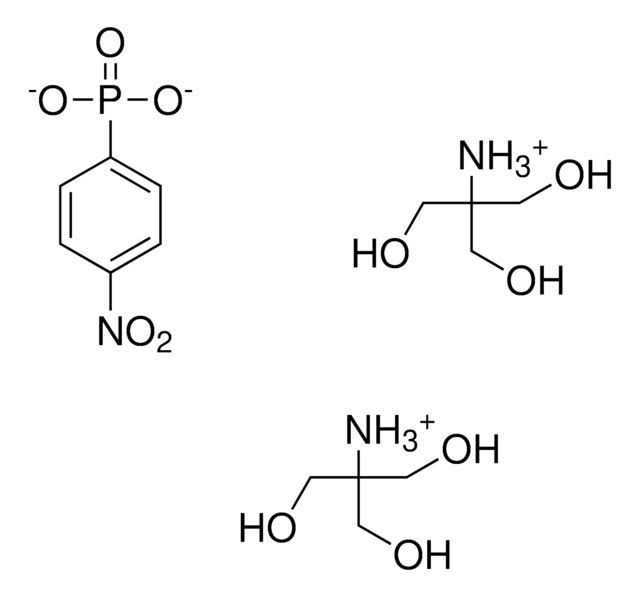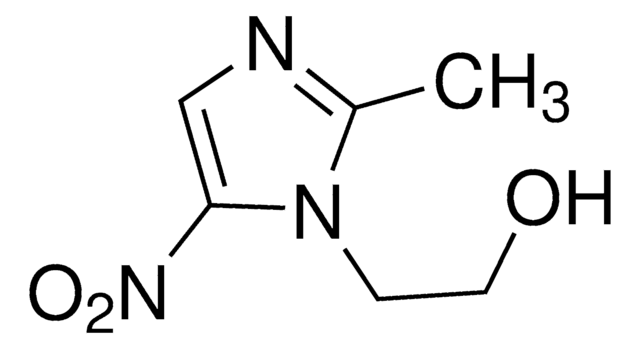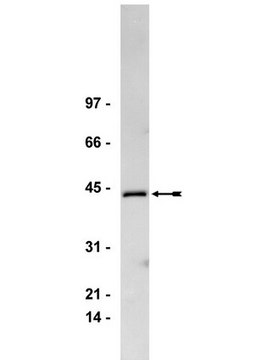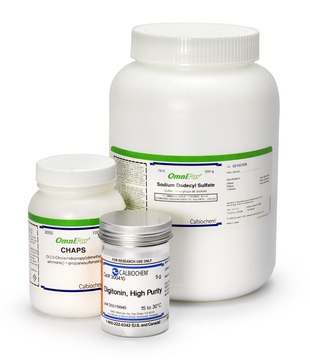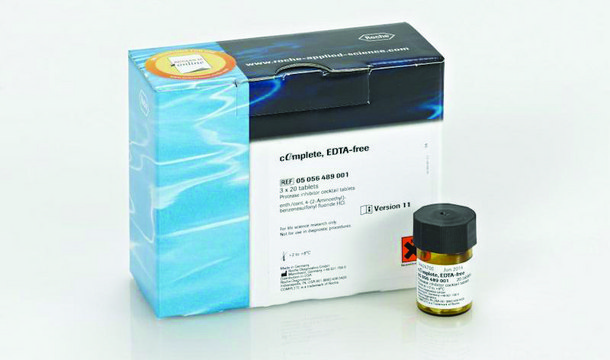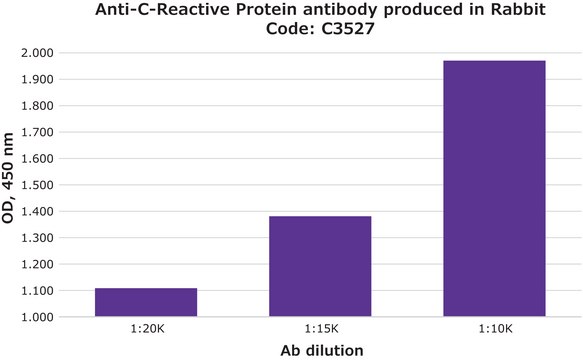推荐产品
生物来源
rat
质量水平
偶联物
unconjugated
抗体形式
purified from hybridoma cell culture
抗体产品类型
primary antibodies
克隆
RCR-379, monoclonal
表单
buffered aqueous solution
种属反应性
human
技术
flow cytometry: 5-20 μg/mL using HUVEC cells
同位素/亚型
IgG2a
UniProt登记号
运输
dry ice
储存温度
−20°C
靶向翻译后修饰
unmodified
基因信息
human ... PROCR(10544)
相关类别
一般描述
Monoclonal Anti-endothelial cell protein C receptor (EPCR) (rat IgG2a isotype) is derived from the RCR379 hybridoma produced by the fusion of mouse SP2/0 myeloma cells and lymphatic cells isolated from the superficial inguinal lymph nodes from Wister rats immunized with human EPCR-positive RE-1 cells. Endothelial protein C receptor (EPCR), also known as activated protein C receptor (APC receptor), is a protein encoded by the PROCR gene in humans and is mapped to the locus 20q11.22. EPCR is a type 1 transmembrane glycoprotein containing two domains in the extracellular region that are homologous to the α1 and α2 domains of CD1/ major histocompatibility complex class 1 (MHC) class 1 molecules. It is expressed exclusively in endothelial cells and small vessels such as capillaries of the alveolar wall in the lung.
特异性
Monoclonal Anti-Endothelial Cell Protein C Receptor (EPCR) recognizes human EPCR (49 kDa).
免疫原
human EPCR-positive RE-1 cells.
应用
Monoclonal Anti-Endothelial Cell Protein C Receptor antibody produced in rat is suitable for flow cytometry at a concentration of 5-20μg/mL using HUVEC cells.
Monoclonal Anti-Endothelial Cell Protein C Receptor antibody produced in rat may be used in immunohistochemistry.
生化/生理作用
Endothelial protein C receptor (EPCR) also known as activated protein C receptor (APC receptor) is involved in regulation of the cytoprotective and anticoagulant pathways of protein C. EPCR is a member of the CD1/major histocompatibility complex superfamily and plays an important role in regulating the inflammatory response. It is also identified as an endothelial receptor for specific P. falciparum erythrocyte membrane protein 1 (PfEMP1) subtypes. EPCR is associated with an increased risk of venous thromboembolism (VTE).
The EPCR protein also performs other functions, like binding to proteinase. The complex then binds to macrophage 1 antigen (MAC-1) on activated neutrophils and inhibits their adhesion to activated endothelium
外形
0.01M 磷酸缓冲盐溶液,pH 7.4,含 15mM 叠氮化钠。
储存及稳定性
For continuous use, store at 2-8 °C for up to one month. For prolonged storage, freeze in working aliquots at −20 °C. Repeated freezing and thawing is not recom-mended. Storage in frost-free freezers is also not recommended. If slight turbidity occurs upon prolonged storage, clarify the solution by centrifugation before use. Working dilutions should be discarded if not used within 12 hours.
免责声明
Unless otherwise stated in our catalog or other company documentation accompanying the product(s), our products are intended for research use only and are not to be used for any other purpose, which includes but is not limited to, unauthorized commercial uses, in vitro diagnostic uses, ex vivo or in vivo therapeutic uses or any type of consumption or application to humans or animals.
未找到合适的产品?
试试我们的产品选型工具.
储存分类代码
10 - Combustible liquids
WGK
WGK 2
闪点(°F)
Not applicable
闪点(°C)
Not applicable
个人防护装备
Eyeshields, Gloves, multi-purpose combination respirator cartridge (US)
法规信息
新产品
Vaheh Oganesyan et al.
The Journal of biological chemistry, 277(28), 24851-24854 (2002-05-30)
The endothelial cell protein C receptor (EPCR) shares approximately 20% sequence identity with the major histocompatibility complex class 1/CD1 family of molecules, accelerates the thrombin-thrombomodulin-dependent generation of activated protein C, a natural anticoagulant, binds to activated neutrophils, and can undergo
Fan Liu et al.
Human genetics, 134(8), 823-835 (2015-05-13)
In the International Visible Trait Genetics (VisiGen) Consortium, we investigated the genetics of human skin color by combining a series of genome-wide association studies (GWAS) in a total of 17,262 Europeans with functional follow-up of discovered loci. Our GWAS provide
Alice G Vassiliou et al.
Intensive care medicine, 39(10), 1752-1759 (2013-07-25)
Endothelial protein C receptor (EPCR) is expressed mainly in endothelial cells and is involved in regulation of the cytoprotective and anticoagulant pathways of protein C. We assessed whether haplotypes in the EPCR gene modify the risk of severe sepsis and/or
Izumi Naka et al.
Malaria journal, 13, 105-105 (2014-03-19)
Cytoadhesion of Plasmodium falciparum-infected erythrocytes to endothelial cells in microvessels is a remarkable characteristic of severe malaria. The endothelial protein C receptor (EPCR), encoded by the endothelial protein C receptor gene (PROCR), has recently been identified as an endothelial receptor
Z Laszik et al.
Circulation, 96(10), 3633-3640 (1997-12-13)
The protein C anticoagulant pathway is critical to the control of hemostasis. Thrombomodulin and a newly identified receptor for protein C/activated protein C, EPCR, are both present on endothelium. EPCR augments activation of protein C by the thrombin-thrombomodulin complex. To
我们的科学家团队拥有各种研究领域经验,包括生命科学、材料科学、化学合成、色谱、分析及许多其他领域.
联系技术服务部门